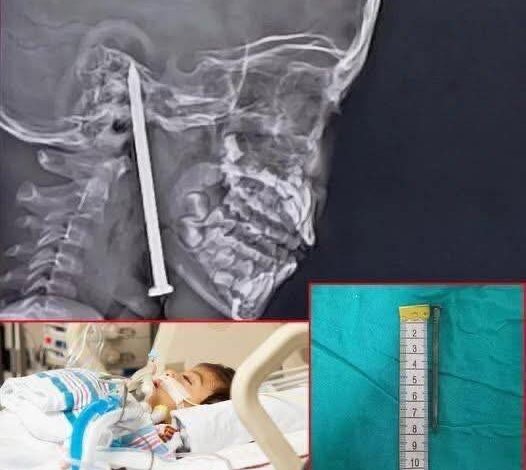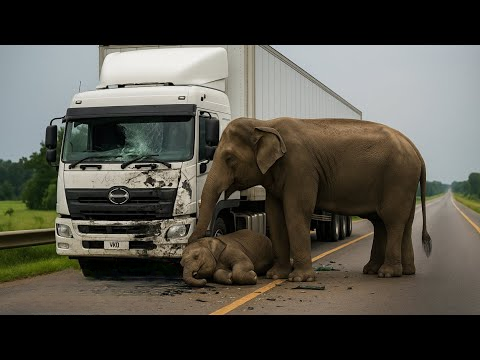In the bustling town of Balrampur, a quiet afternoon on the playground turned into a nightmare for one family when a freak accident left a seven-year-old boy fighting for his life. What began as ordinary play with his friends ended with a three-inch nail embedded in his neck, extending dangerously into his brain. Yet against all odds, the boy survived—a survival so remarkable that doctors are now preparing to publish his case in international medical journals as a milestone in pediatric emergency care.
The accident happened in a matter of seconds. Witnesses recalled the boy had been climbing on a wooden structure when he slipped, striking a part of the play equipment that had a protruding nail. The sharp piece of metal drove into his skin with devastating force. Screams erupted across the playground as adults rushed to help, but nothing could disguise the horror of what had happened. Blood trickled down his small frame, his eyes wide with shock, but incredibly, he was still conscious. His friends stood frozen, unable to comprehend what they were seeing.
His terrified parents wasted no time. They rushed him to King George’s Medical University (KGMU), one of the region’s top facilities, where trauma specialists immediately ordered scans to assess the extent of the damage. The MRI revealed something both terrifying and extraordinary: the nail had pierced deep into his head but had somehow missed a vital blood vessel by the smallest of margins. Had it shifted even a millimeter further, the outcome could have been catastrophic.
The team at KGMU knew they had no time to waste. Neurosurgeons and ENT specialists quickly assembled, forming a surgical unit prepared for one of the most delicate operations they had ever attempted. The challenge was immense: removing the nail without causing irreversible harm to the boy’s brain tissue or triggering massive bleeding. Any misstep could end his life on the operating table.
For four tense hours, the surgical theater was a scene of unwavering focus. Every movement was calculated, every instrument handled with precision. The surgeons carefully navigated around sensitive structures, slowly dislodging the nail millimeter by millimeter. Outside the theater, the boy’s family sat in anguish, praying for a miracle. Nurses moved quietly in and out of the waiting area, offering updates that did little to ease the tension.
Finally, the doors opened. The team emerged exhausted but victorious. The nail had been successfully removed without damaging any critical areas of the brain. The relief was overwhelming. The boy’s parents broke down in tears, thanking the doctors who had just saved their child’s life.
Following surgery, the boy was transferred to the Pediatric Intensive Care Unit (PICU), where he was closely monitored around the clock. Specialists kept watch for any signs of infection, swelling, or neurological complications. To their astonishment, his recovery progressed smoothly. Within days, he was stable, responding well to treatment, and even able to communicate with his family. His first words brought tears of joy to his mother’s eyes—proof that her child’s mind had emerged intact despite the unimaginable ordeal.
The case has been described by the KGMU medical team as one of the most extraordinary they have encountered. While children are often admitted with traumatic injuries, the survival of a boy with a nail penetrating so close to major blood vessels and vital brain structures is almost unheard of. The hospital’s neurosurgery department has already begun drafting a detailed case report, set to be submitted for international publication. They believe this story will serve as a learning milestone in emergency pediatric neurosurgery, highlighting the importance of swift diagnosis, advanced imaging, and expert multidisciplinary collaboration.
For the boy’s family, the experience has been nothing short of life-changing. They described their emotions as swinging between despair and gratitude, never forgetting the moment when they thought they had lost their son forever. “God sent these doctors to us,” his father said quietly, clutching the hand of one of the surgeons who operated on his child. “We will never forget what they did.” His mother added that every time she looked at her son, she was reminded of the fine line between tragedy and miracle.
The incident has also raised larger questions about playground safety. Community leaders and parents have begun calling for stricter maintenance of public play areas, noting that such accidents are preventable. Nails, sharp edges, and poorly maintained equipment can quickly turn spaces meant for joy into sites of trauma. “This little boy’s survival is a miracle,” one local teacher said, “but it’s also a warning. We can’t rely on miracles. We need safe environments for our children.”
The medical community has echoed this sentiment. Doctors pointed out that while the operation ended in success, it could easily have gone the other way. Preventing accidents in the first place is far better than relying on surgical miracles. They have recommended regular inspections of playground equipment and greater awareness among parents and caretakers.
Still, amid these warnings, the focus remains on the boy’s recovery. Each day in the PICU has brought progress. The swelling around the wound has gone down, his energy is returning, and specialists are optimistic that he will regain full neurological function. Physiotherapy will help him strengthen his neck and coordination, but he is expected to live a normal life.
For the doctors who saved him, the case is more than just a professional triumph. It is a reminder of why they chose this demanding career—to face the impossible and sometimes win. For the family, it is proof that hope should never be abandoned, even in the darkest moments. And for the wider world, it is a story of resilience, skill, and the extraordinary will to survive.
In Balrampur, the boy has already become something of a local symbol of strength. Neighbors have begun calling him “the miracle child.” Strangers have reached out with messages of support, and social media has lit up with prayers and praise for the medical team.
Looking back, the accident could so easily have been a tragedy. A misjudged step, a rusty nail, and a matter of millimeters nearly robbed a family of their son. But instead, it has become a story of survival that will inspire others for years to come. The boy himself may be too young to understand the magnitude of what he endured, but one day he will grow up knowing that he faced death and overcame it with the help of modern medicine, brilliant doctors, and perhaps just a touch of fate.
The nail that nearly ended his life now sits in the hospital archives, a grim reminder of what was at stake. But the real legacy of this case lies in the boy’s smile, his parents’ gratitude, and the knowledge that even in the direst circumstances, miracles—backed by science and skill—are still possible.


